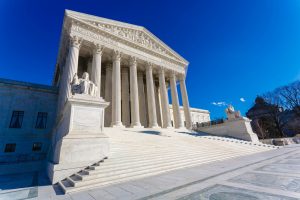On Wednesday, June 18, 2025, the U.S. Supreme Court (SCOTUS) laid down rules to resolve split circuit court opinions, determining which EPA Clean Air Act (CAA) cases should be heard by regional district courts and which must be heard by the D.C. Circuit Court of Appeals.
Before making its determination, SCOTUS heard two cases:
- EPA v. Calumet Shreveport Refining
- Oklahoma v. EPA
The Calumet case concerned biofuel blending requirement exemptions for small refineries.
“The 7-2 ruling held that the U.S. Court of Appeals for the District of Columbia Circuit, and not the New Orleans-based 5th U.S. Circuit Court of Appeals, is the proper court to hear a lawsuit by small oil refiners challenging the EPA’s denial of waivers exempting them from national biofuel mandates,” according to Reuters.
The Oklahoma case involved rejected state implementation plans (SIPs).
“Yet under the same test to assess venue that the justices announced in the refineries cases, they ruled 8-0 that a different set of lawsuits by the Republican-led states of Oklahoma and Utah and several energy companies including PacifiCorp challenging the EPA’s ‘Good Neighbor’ smog control plan were wrongly transferred to the D.C. Circuit.”
The justices used a CAA provision “that designates the D.C. Circuit as the exclusive venue for cases over ‘nationally applicable’ EPA actions and rules but leaves cases concerning only local agency actions to regional federal appeals courts,” Reuters continues. Cases “must be heard by the D.C. Circuit ‘if a justification of nationwide breadth is the primary explanation for and driver of EPA’s action.’ That justification must supply a ‘core justification’ for the EPA’s action, Thomas said, as it did in the case of the six refineries, whose requests for biofuel mandate exemptions were denied based on an interpretation of the [CAA] that the agency applied to all refineries regardless of their geographic location.”
When initially heard, both cases created a circuit split decision.
Venue test
Under Section 307(b)(1) of the CAA, the majority opinion found there are three pathways to determine the proper venue to challenge EPA actions:
- First, challenges to “nationally applicable” Agency “action[s]” must be brought in the D.C. Circuit.
- Second, challenges to “locally or regionally” applicable Agency “action[s]” must be filed in the appropriate regional circuit.
- Third, as an exception to the second rule, challenges to locally or regionally applicable Agency actions belong in the D.C. Circuit if they’re “based on a determination of nationwide scope or effect.”
Different venues have different implications for litigants.
“The D.C. Circuit has the most extensive precedent on CAA and administrative law matters, but it is sometimes perceived as more deferential to agencies,” law firm Holland & Knight LLP says. “Regional circuits may be more attuned to local concerns and offer opportunities to develop case law in ways that may be foreclosed by the D.C. Circuit’s extensive precedents in those areas.”
With SCOTUS delivering split judgments in these matters, taking the EPA’s side in Calumet but ruling against the Agency in Oklahoma, the high court has created a subtle structure to determine the proper venue for CAA cases.
“The Court’s new and reticulated test for assessing venue disputes under the Act strikes me as both mistaken and likely to render simple venue questions unnecessarily difficult and expensive to resolve,” wrote Justice Neil Gorsuch in the dissenting opinion, joined by Chief Justice John Roberts.
Takeaways
“Stakeholders and EPA regulators must now carefully analyze the geographic nature of the action, particularly how it is framed in the CAA itself rather than packaged by EPA,” advises Holland & Knight. “Additionally, for local actions where EPA seeks to centralize D.C. Circuit review by asserting the action is ‘based on a determination of nationwide scope or effect,’ stakeholders and the EPA itself will have to closely assess the centrality and nature of EPA’s reasoning. “As EPA Administrator Lee Zeldin continues to pursue his deregulatory agenda, there may be instances where the EPA strategically prefers regional circuit review versus D.C. Circuit review. For EPA to secure D.C. Circuit venue for actions affecting multiple discrete states or facilities, its decision must be primarily based on generic reasoning that applies uniformly, nationwide – the more like boilerplate, the better. When the agency’s reasoning combines generic principles with site-specific facts, proper venue determinations can become more complicated if EPA chooses to invoke the D.C. Circuit exception.”

